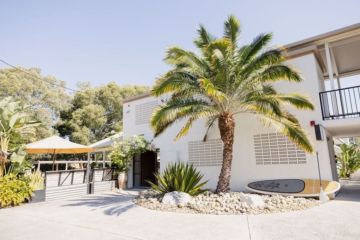Baby, it's hot outside: seven ways to reduce your energy costs this summer
With summer in full swing and temperatures on the rise, there’s one thing you want to stay very low – and that’s your energy bill.
According to the Australian Energy Market Commission, average national residential electricity prices increased by 4.4 per cent between 2015/16 and 2016/17, and are expected to increase another 2.7 per cent in 2017/18.
While provider costs may be rising, the good news is there are still plenty of ways to lower your bills with the right knowledge, gadgets and appliances.
Try reducing your energy costs this summer with the following expert-provided tips.
Live track your energy usage
“Ignorance might be bliss – but not when it comes to your energy bill,” says Bunnings electrical category manager, Tracey Lefebure.
To avoid an unexpectedly high bill this summer, live track the usage of your home’s plug-in appliances with an app or energy meter.
“There are a bunch of apps and devices now that can help tell you how much energy your home is using, help you compare with your neighbours and give you energy-saving tips,” says Rob Murray-Leach, head of policy at Energy Efficiency Council – Australia’s peak body for energy efficiency, cogeneration and demand management.
Tracking your power usage not only helps keep energy bills to a minimum, but also helps identify appliances with a higher-than-preferable energy consumption.

“Ignorance might be bliss – but not when it comes to your energy bill”. Photo: Ausgrid
Use energy-efficient appliances
The golden rule of appliance shopping is to purchase products with the most amount of Energy Rating stars for your budget. While it may be tempting to purchase the cheaper fewer-star equivalent, this will generally cost more in the long-run.
“Really efficient appliances can use 75 per cent less energy than older models,” Murray-Leach says.
“Star ratings used to be out of six, but now they’re out of 10. Generally, seven to 10 stars is very efficient.”
For those with a limited upfront budget, Murray-Leach says the most important appliances to invest in are an energy-efficient airconditioner/heater (if required), fridge and water heater.
“It’s important to focus on the big things. With your energy bills, roughly 40 per cent is heating and cooling, a third is appliances (especially your fridge and freezer, which are on 24/7), and 20 per cent is water heating,” he says.
Another tip is to switch off appliances such as TVs and microwaves at the wall when not in use, as some still use considerable energy even in standby mode.
Set your airconditioner to a higher temperature
Resist the temptation to turn the air conditioner to its lowest temperature, even on scorching hot days.
“Each extra degree cooler can add 10 per cent to your cooling costs,” says Kirsty Lamont, director at comparison site Mozo.com.au.
Experts recommend setting the airconditioner thermostat between 24 and 26 degrees in summer.
“If you try to make your home much colder than the outside, your airconditioner has to work a lot harder. It also means that your body gets a really unpleasant ‘shock’ when you go outside,” Murray-Leach says.
If you’re expecting a very hot or humid day ahead, prepare in advance by turning on the airconditioner before the house heats up, not after.

It’s tempting, but unwise, to set your airconditioner to freezing. Photo: Glenn Hunt
Look after your appliances
Regularly clean and maintain your appliances to ensure they’re not being overworked in the warmer months.
“Generally, you want your fridge to be around two-thirds full and your freezer to be at least three-quarters full. Appliances that are filled to the brim will decrease air circulation and take longer to cool,” says Angus Kidman, editor-in-chief and tech expert at finder.com.au.
“To trim your cooling costs, remember to clean your airconditioning units every couple of months, and also make sure your airconditioner is appropriately sized for your property.”
Limit housework
Give yourself a housework-free pass on hot days. Not only will housework such as cooking over the stove, vacuuming and mopping heat your body up, the resources and equipment these tasks require will also raise your home’s overall temperature.
“For instance, you could make the most of balmy summer evenings by barbecuing outside or enjoying quick, throw-together meals like pastas and salads instead of firing up the oven,” Lamont says.
Seal and shield your home
Cover up or seal any draughts to limit the amount of outside air entering your home.
“Even old-fashioned door snakes will do the job. If you want to go further, there are draught stoppers for doors and adhesive sealers for windows as well,” says Sustainability Victoria CEO Stan Krpan.
Curtains, blinds, insulation and double glazed windows are other methods to help deflect heat on hot days.
“You can buy inexpensive window film, which will keep out the sun and is much cheaper than double glazing,” Krpan says.
“Insulation can be purchased and installed yourself and there are often in store promotions on these items during summer or winter.”

It’s a good idea to insulate and seal you home. Photo: Getty Images
Choose a quality energy provider
Energy prices and deals vary between companies, so take your time to research before signing up to a particular provider.
“When selecting an energy provider, you need to understand your usage habits. For instance, there are plans that offer different rates of energy at different times of the day, ones that offer options for heavy and light energy users, and plans for those who are conscious of reducing their carbon footprint,” Kidman says.
While we all love a bargain, cost isn’t the only factor to consider.
“There are greater factors to consider than just saving money when choosing an energy provider, like, ‘Where is your money going?'” says Tamara DiMattina of The New Joneses.
Research all the elements that are important to you, whether they be cost, ability to track usage, company transparency, emissions, renewable energy or solar power.
“It’s important to go with an energy retailer that you trust and avoid gimmicky deals. Some retailers make these offers that sound really good, but once you’ve been with them for a bit, their rates rise,” Murray-Leach says.
Websites such as Energy Made Easy, Switch On, and The Green Electricity Guide help consumers to make informed decisions when choosing an energy provider.
We thought you might like
States
Capital Cities
Capital Cities - Rentals
Popular Areas
Allhomes
More







